How it all began: developers remember the first games they created

Surely, many game developers, being children, often heard criticism. We were reproached for wasting too much time, living in a fictional reality ... However, the hours spent on game consoles turned out to be very fruitful, and the youthful enthusiasm, which at first glance was useless, turned into a real profession that brings nothing comparable pleasure.
We have prepared for you the translation of an article from Gamasutra , so that you can learn about the first steps of famous developers in the world of game dev with us.
Every game designer began something: from a small funny project on Twine, from drawing a D & D module onto a piece of paper in a cage, from a new level of Mario drawn in the school notebook, or from inventing the “home” rules Risk and Monopoly.
')
Everyone remembers that key moment when they realized that they could invent their own rules, tell interactive stories, create systems and virtual universes.
Editorial Gamasutra contacted several successful developers who shared their game creation stories. We were stunned and inspired by these stories, and we think that they will impress you no less.
Goichi Suda (Killer 7, Let it Die)
As a child, I played a variety of analog games. When I was in the 3–4 classes of elementary school, the war game was very popular, where it was necessary to attack enemy combat forces with a pencil, moving their tanks, aircraft carriers and jet fighters. The card was the back side of a newspaper, on which hundreds of variants could be drawn, so my friends and I went along a new route every day.
After that, I took up the development of my game with pencils. It was a race. As before, I daily laid a new course for our company. The biggest was the racing with 50 levels, but the rules turned out to be so complicated and the process took so much time that friends quickly got tired and lost interest.
The first attempts to create my own game and history became one of the happiest memories for me. Probably in my career as a game designer this was the starting point.
Sam Barlow (Her Story, Silent Hill: Shattered Memories)
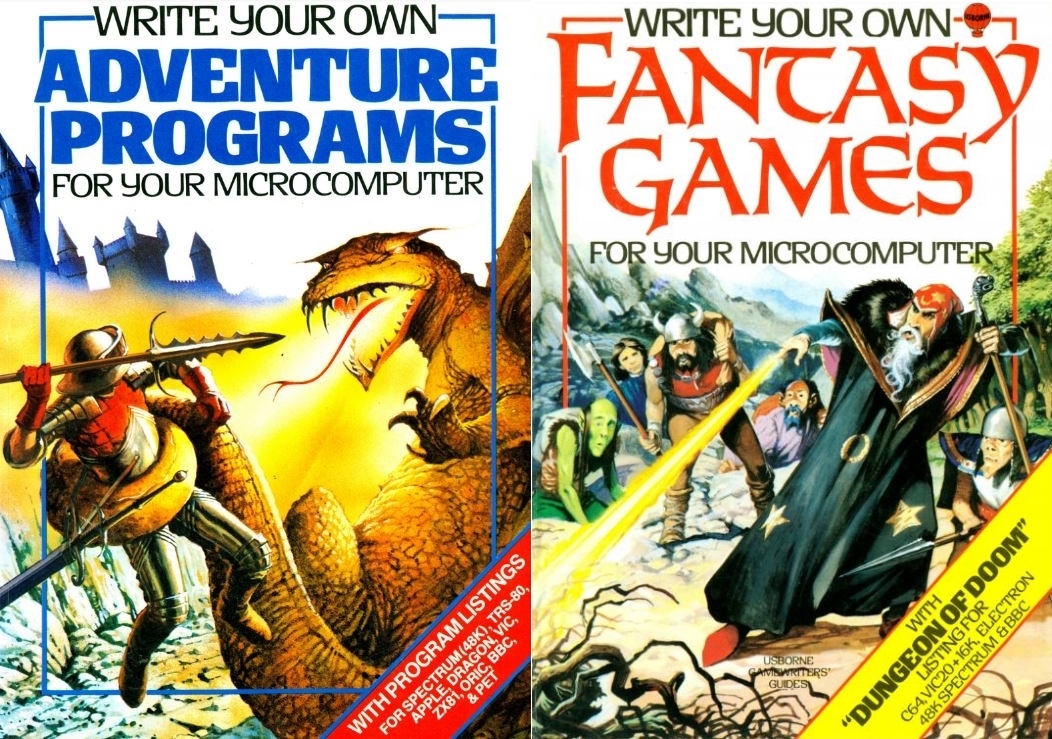
Now game programming books published by Usborne in the 1980s are available in free PDF format .
I grew up in the 80s and I owe my knowledge in the field of game creation to type-in printouts that our generation diligently copied from magazines. It is also worth mentioning the books of the publishing house Usborne, on the covers of which there were intricate illustrations: dragons, knights and incredible magic!
When I was a teenager, I came up with a series of text games telling about the romantic adventures of one of my friends. The plot, equally inspired by the BBC's “Bottom” sitcom and Infocom games that I adored, was pretty dashing and slightly obscene. As I recall now, the basis of my creations was a certain antagonism between the narrator and the intended audience and the peculiar humor of my friends, who drew him from the awkward situations that had once happened to them. Even then, I was thinking about the complex relationship between the creator and the user in an interactive story.
And this is Social Realism Dizzy, which I wrote for my friends at Qbasic, a hilarious parody of the popular, but terrible games of Dizzy.
Full size image is available here .
Paul Franzen (The Beard in the Mirror, A Stranger Comes Calling)
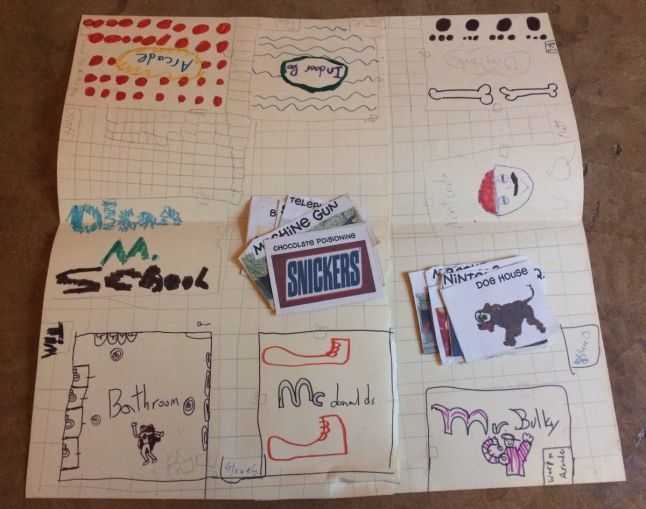
Full size image is available here .
I made my version of Clue (Cluedo) when I was in high school and was still a nerd. I replaced all the rooms with McDonald's and Nintendo HQ. The murder weapons turned into an anvil, poisoned chocolate and submachine guns (I was mad about Wolfenstein then), and my friends and I became probable killers. It was a lot of fun! I still have this game.
I think it was then that my inclination to integrate the elements of my personal life into the games that I create was first manifested. With my later work, Cat President was the same story: most of the character portraits were real photos of my family's cats and friends.
Tanya Short (Moon Hunters)
Partial image of the world map of Aetolia.
When I was a teenager, my mother was worried about the fact that I spent too much time playing video games (absolutely right, I think), and she deprived me of that opportunity altogether. She did not realize that she herself had pushed me into the open arms of multiplayer games - the textual predecessors of modern MMOs. I was fascinated by the characters, stories, and laws of life of these virtual universes so much that at some point I ran out of games, and I began to devote time to what I created and animated my own worlds.
A few years later, after finishing college, I began working with Iron Realms Entertainment and working on their commercial MMM Aetolia. In 2005, I realized that I like to give life to new characters and develop systems much more than just playing. I already had a full-time job - I taught English in Japan, but still I worked out quests, locations and objects for hundreds of hours, and organized events. And it turned out that I was doing quite well. Realizing this, I decided that every effort should be made to build a career in game design and get paid for what I am ready to do for free.
Toby Fox (Undertale)
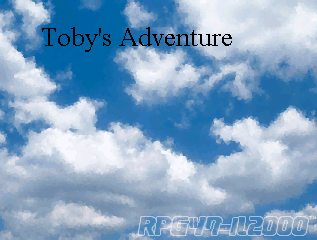
I created my first game on RPG Maker 2000. It was called Toby's Adventure. I don’t remember anything about it, except that the music theme was a wav file with my singing and attempts to make trumpet sounds.
Lucy Blundell (One Night Stand)

I got my first impressions about games when I was about 10 years old. I spent a lot of time at the computer, playing Worms and Worms: Reinforcements with a friend, but instead of trying to destroy the enemy in each round, we created bases for the underground of our teams. The bottom line was to build a protected base for a certain number of moves, before the rain from air attacks destroyed it destroying it. The one whose team lasted longer, won. We liked to play this way: in this way there was less aggression and rivalry.
Around the same time, I was fascinated by the level editor in Micro Machines 2: Turbo Tournament. And yet, he seemed a bit restrictive: I wanted to make my levels from scratch. I remember how I drew tracks on paper, but then it didn’t turn into a full-fledged project.
Marc Flury (Thumper)
When I was in fourth grade, I was taught how to work at Logo (also known as Turtle Graphics) on the Apple IIGS. It was a simple programmable drawing tool. We were given the task to depict several simple forms, but I liked the Logo so much that I went a little beyond the framework and created the whole winter scene with snowmen, mountains, snowflakes and so on. I even tried to create an animation by “redrawing” some sections and making them “move” across the screen. My teacher was amazed! Unfortunately, then I did not understand how important this is and how it generally relates to programming and game development. Only many years later, I again did something with the help of computer graphics.
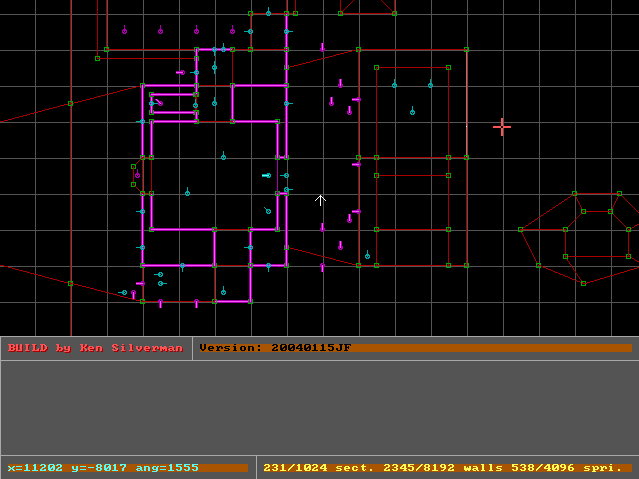
Game engine editor.
In high school, I used the Duke Nukem 3D editor to create a map of the level, which was the plan of my school. I accurately modeled the whole building. This painstaking process took a lot of my time. Like many, I desperately tried to present my school as a space with different conditions - not the ones in which we were forced to exist. Not that it was very bad there, but at that moment it seemed as if I was locked up in prison.
Now I would like for me to do something more original and interesting at that time, but creating my own world, expanding the boundaries of the possible, was a kind of way to escape from reality. It is unfortunate that most children do not have such a creative outlet. I would not like to talk lightly on such a terrible topic, but when I see the next news about violence with the use of weapons in schools, I am not very surprised.
Anna Kipnis (Psychonauts, Broken Age)
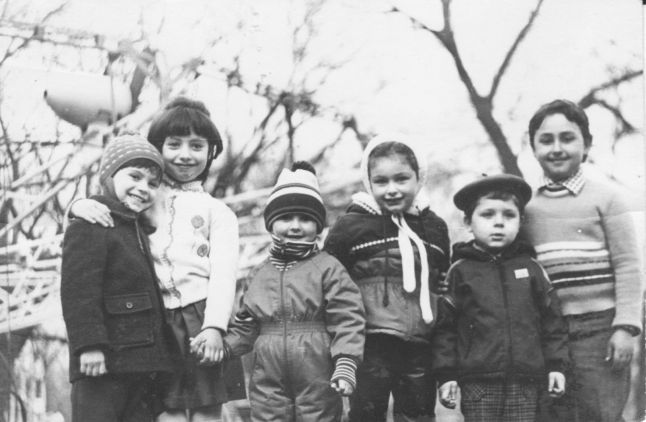
Kipnis is second from left.
My parents loved to have parties. Their friends often came with their children, and I, as the most adult of the children, were responsible for leisure and came up with entertainment for us. Most often, they were ordinary street games with typical mechanics, complemented by interesting plot twists.
One of these games, as I recall, was a combination of hiding and catching up. It began just like ordinary hide-and-seek: everyone hides - one searches. The difference was that the seeker was a creepy magical creature (the growl and grumble were encouraged) and had the power to turn hiding into a seeker when the leader touched the players found. He who hid himself immediately joined the monster team and helped to find the others. Hiding, in turn, were hiding in a safe place where seekers could not reach them (depending on the number of players, the number of such places varied). The seekers won if in three rounds they found everyone who was hiding. If in some round they couldn’t find them for 10 minutes, they turned one of the monsters into a regular player. If in each round they could not find in time at least one of those hiding, the ones hiding would win. It is worth noting that at first this game was much easier. Rules with a safe zone and what can turn you into a seeker, and vice versa, appeared much later.
The most interesting thing was to discuss with the guys what a fun rule to introduce, and test it in action. We vividly argued about how long the seeker must wait before starting the search, how long the round should last, how fast the monsters can move (maybe they will be “slow”), what forces the seeker should have, and so on. It was really great to see the children invent mechanics, drawing inspiration from the images of fictional scary monsters, and not based on considerations of dry, dull balance. I really liked to watch them get into the role of monsters, even if it meant that the hiding knew about their approach.
The right to introduce official rules belonged to me, but we invented them together. How wonderful was the feeling that fiction, once a vague idea in my head, becomes a reality. The guys were so inspired that they had quite definite opinions about how the game should develop, and they even composed stories about the past of monsters-seekers. We did not manage to equalize the balance due to the difference in age, but the atmosphere was very cheerful!
Now, when I reread it, it seems as if the game was about zombies. But please note that in the USSR there was no cinema about zombies, so we were more like folklore monsters.
James Earl Cox III (You Must Be 18 Or Older To Enter)

Full size image is available here .
I made my first full game at 13 years old. It was a card game: laminated postcards with obverse sides with printed crayons and pencils and printed shirts. It was called Thriblets and assumed the allocation of resources and battles. I remember that by creating it, I wanted to solve the problems that had arisen with Magic: the Gathering: not all my friends could afford Magic cards, and if they still managed to get them, the decks were still worse than those of the more affluent guys.
I wanted to develop a game with resource allocation and less difficult levels than in Magic, where everyone would have equal chances of winning and access to the same cards.
So I made Thriblets. Many did not understand why I need this, but I felt just awesome playing with my friends. We constantly received new experience and improved in the process of passing levels. I didn’t know it yet, but each of our games was very effective testing. I liked the idea of creating my own systems: it was not my version of Magic, but a game that corrected my claims to Magic.
In the end, I shifted my efforts to a desktop strategy with paper figures: the rules of Warhammer 40,000 are even more difficult than Magic: the Gathering, and the money barrier is even higher. I wanted to challenge her too.
Adrian Bauer (Owlboy)
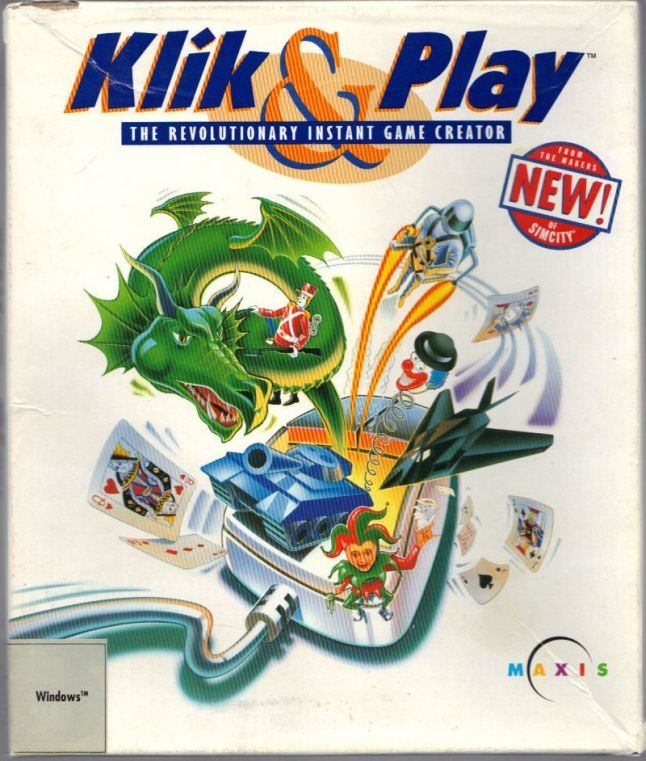
I made my first real game at Klik & Play. It was supposed to be my answer in the style of Sonic RPG to the Super Mario RPG project on SNES. Horrible graphics, inappropriate music in midi format and a ton of ambitions! I did not understand where I was going, but I was going to get there quickly.
The biggest obstacle was that Klik & Play had no easy way to transfer data across levels and the ability to scroll the screen. The software supported no more than four players and gave them global values of lives and scores. I began to research the work of the password system in Wonderboy III and think about how to use them.
In the end, I made a few puzzles and scenes that remained constant in the eight-digit system. I was fascinated by this process - I wanted to make as many games as possible. It was then that I discovered that I was beginning to emerge from my usual environment: textbooks, classes in elementary school, and cartoons on Saturdays. I needed to constantly create something new and invent worlds.
Continuing to use the Kilk tools over the years, while they were slowly updated and changed, I constantly encountered the limitations of the program, finding workarounds, as was the case with the password system. I also got into animation and comics, but focused mainly on game development.
I have always had a thirst for creation. My father invariably provided me with paper and pencils so that there was much room to throw out all this energy. I am very happy that my parents helped me focus on my passion and gave me complete freedom of action.
Rami Ismail (Nuclear Throne)
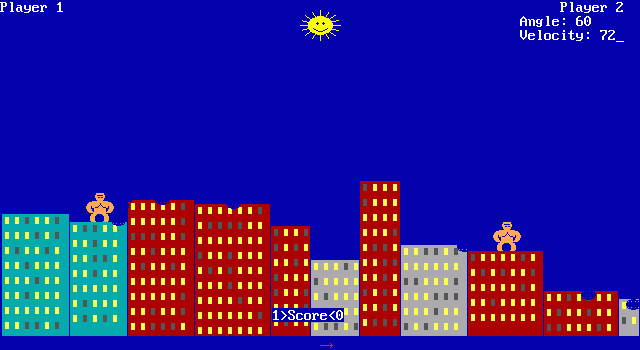
The first game I found out was called GORILLAS. It was a MS-DOS-QBasic game that came into my life with our first home computer. I was then 5 or 6 years old, and I already tried to do something with it. Knowing that I could find games, I ran the modules, but always without success. Until QBASIC.EXE is launched. QBasic is a software environment for the QuickBasic programming language, which was bundled with tutorial files. NIBBLES.BAS is Snake, and GORILLAS.BAS is something like Tanks, only with gorillas. I looked at the code and pressed F5 to run it.
Then I did not know how to read English, but one day I managed to find the text of the main menu in the code. I changed it to RAMI, started the game and saw my name instead of the usual menu. From that moment I knew that computers were translating words into games, and I did not stop trying to figure out how to do it.
Locomalito (Cursed Castilla)
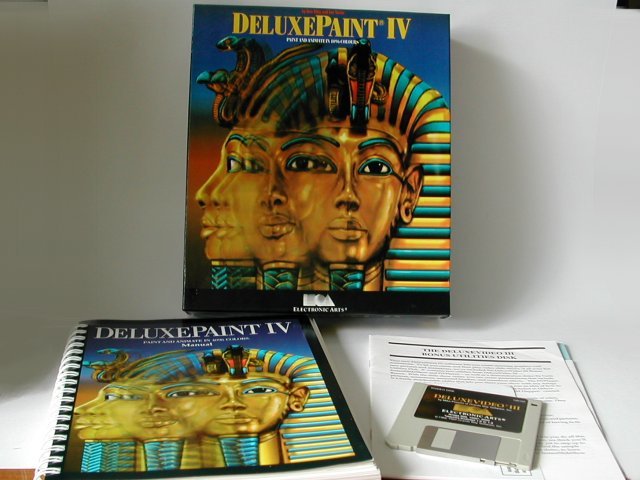
When I was a child, one boy from our company called everyone to his home to play something new, which he called the “video game console”. It was Atari, and for some reason it seemed rather boring to me. Only years later, when I first saw an arcade machine with Phoenix, I was impressed by the video game: the lone pilot was fighting in space with giant alien birds, and everything was so dangerous and fantastic that I fell in love.
After many years of practice, I finally finished off the R-Type (with a loan, as I usually could not continue due to lack of coins), and thanks to this incredibly difficult victory, I felt enough confidence in myself to create my own project one day. And I created ... 20 years later!
I started making graphics on the Amiga 500 using Deluxe Paint IV, but, alas, after the move I lost all my CDs, so now I can't even check if I became better.
Hifumi Kono (Clock Tower)
I made my first game when I was at university. Inspired by Up Front from Avalon Hill and other similar projects, I wanted to create a simple analog card game. The bottom line was to assemble a gang of yakuza, to accept new members, to build up our wealth and fight — quite grimly, but we and our friends liked it.
Alex Schwartz (Job Simulator, Dyscourse)
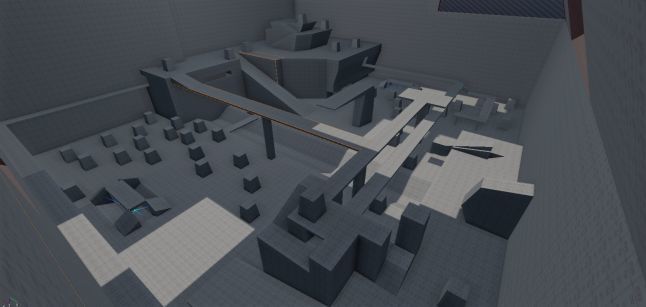
Sweep Hang 'Em High.
The first sign that I was destined to become a game designer, showed up at a drawing lesson in high school. We needed to create floor plans for an architectural project open to edits, and I decided to draw (from memory) the Hang 'Em High level from Halo. It was my plotting teacher who suggested that I start developing video games after we talked to him about the future. So if you read this, thank you, Mr. Macmillan!
Camila Gormaz (Long Gone Days)
My parents were not the ones who buy everything their child asks. Therefore, if I really wanted something, I tried to do it from the things I had.
One of these “hotelok” was Kirby Super Star. I was then 7 years old. I remember how Kirby painted on a small piece of paper and different levels in her sketchbook. I moved Kirby along these monstrously light levels, and over time I began to add mini-puzzles between them and even create three-dimensional books to make the levels more interesting.
I began to share these educational books with friends and realized that I much more like to do something for others than to play myself.
With age, I switched to computer games, I learned about Flash and other engines. I was inspired by the work that I saw on Newgrounds, and I began to wander through the forums. It was then that I realized that I wanted to be engaged in development until the end of my days.
I don’t have these books left, the oldest one I’ve saved is sprites for Long Gone Days. Analog drawing of 2003.
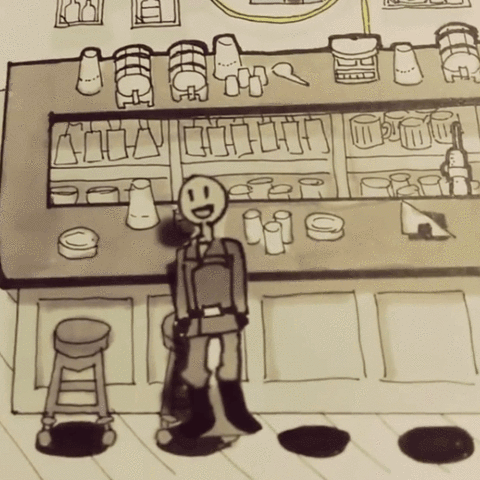
Analog version (2003).
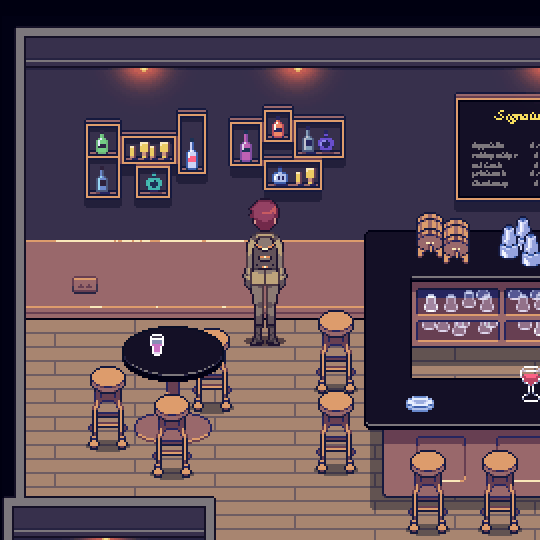
Digital version (the game is expected in 2018).
Thomas Casamento (Overdriven)
I am a musician. For years, I sent summaries to various video game developers in the hope of becoming a composer.
The job search did not give fruit, and I decided: since it is impossible to find a serious project for which you need to write music, I will make the game myself! In the process, I realized that I really like to create games, rules, structure and code that gives them life.
I was releasing my project, and it became more important than writing music. I coded my own shmup engine, drew sprites and recorded the soundtrack. I previously worked on projects such as Tintin, Michael Jackson and Just Dance 2, Killer Freaks From Outer Space and ZombiU at Ubisoft. But Overdriven is the first game I developed myself (a new version is now available on Steam).
Nathalie Lawhead (Armagad)
bluesuburbia
I started my career as a network artist. I have always been interested in this area and how interactivity and art on the web can influence the emergence of new types of expression of creativity that have yet to be explored. At least, when choosing a profession, I was guided by this. When I began to create, rather than “daunting,” I was already finishing high school and preparing for college. It was the era of the dotcom bubble. Spending most of my time in the library, I planned what I would draw upon returning home, and during the lessons I sketched. My world existed online, and all I wanted was to create. None of the friends knew about my hobbies: I did not share with anyone.

Most of all at that time I was working on a project called BlueSuburbia (you can still play it here). I set about creating a world based on interactive poetry, which you not only read, but feel.
In the meantime, I seriously wondered if I should attend college. I did not see my future here. Almost all teachers advised to stay away from computers and “these are your Internet sites”, believing that they are killing creativity, and I really wanted to be part of the Internet. Therefore, relying on my artistic abilities, I decided to play by my own rules. Looking back, I do not regret anything.
Natalia Figueroa (Fran Bow)

My first Fran Bow game - it looks a little different than Fran Bow now.
Isaac Martinsson and I were initially interested in films and animation. We had a long past in art, writing and composing. It turned out that the games combine everything that we love: art, music, stories, creation of worlds and animation. Plus something new for us: programming and design. We realized that we could learn, and this was a very strong motivation.
After we saw Indie Game: The Movie, it became clear that our dream is quite achievable and we can make the game even at home - we just need to learn something and find out which software to use.
Fran Bow is based mostly on my life: its worst period, mixed with the brightest moments. The absence of a father, sexual abuse, drugs that did not help, the move from Chile to Sweden and the associated need to adapt to a new culture - all this became the basis for my creation. I think it was the best three-year therapy you can imagine.
Don Thacker (Starr Mazer)
When I was in high school, I created a game with well-developed Speed-Ball levels (let's not dwell on this unfortunate naive name). She was an action-platformer that, in essence, was a mixture of Bonk's Adventure, Sonic the Hedgehog and Super Mario Bros. with a pinch of Mega Man, where you had to defeat the master enemies and take their power.
The main character is the unsuccessfully named Speedball and his friend Marble, who lived in Pinbola's “Superworld” inhabited by intelligent anthropomorphic steel creatures with their own characters and personal musical themes - I stole this concept from Tron. Spider-ball, Aqua-ball, Ice-ball, Motor-ball ... well, you understand. There were a total of 503 variations, and I remember how hard I worked on them.
The levels were non-original, and each idea was a slightly modified element of the games that I liked then. But the process itself allowed me to learn a lot about game design. By copying these elements, I unknowingly took what I intuitively considered the best, ignoring the less impressive parts. If you devote a lot of time to this and give your love, you create art.
Source: https://habr.com/ru/post/321036/
All Articles